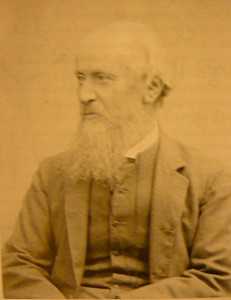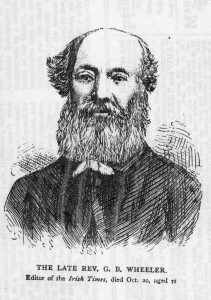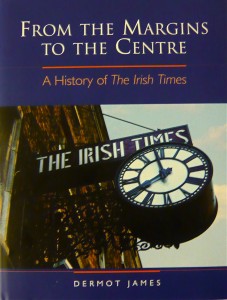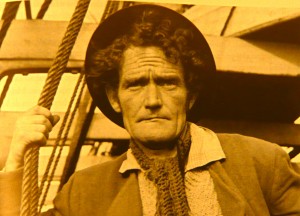FROM THE MARGINS TO THE CENTRE – A History of the ‘Irish Times’ –
(by Dermot James, The Woodfield Press, Dublin, 2008)
A Book Review
THE BEST TIMES, THIS SIDE OF THE ATLANTIC:
Why write a book review in 2009 for a title that was published in 2008?
Well, you may well ask – because THIS year it is the 150th anniversary since the foundation, in Dublin, of the Irish Times: given the tormented history of Ireland during these last century and a half, it is short of a miracle that such a newspaper had survived at all. With the demise of the Anglo-Irish ascendancy, many people were ready to sing the funeral march of this newspaper: well it did not happen! -The Irish Times survived to tell the story and Dermot James, himself a journalist and old employee produced this magnificent narrative.
This anniversary is that much more extraordinary as it proves the immense quality of adaptation to a very dynamic political, social and cultural Irish stage undergoing a complete sea-change. For the last 150 years Ireland had witnessed events which are still vividly recalled in Britain, America, Europe and in all four corners of the world where the Irish diaspora was dispersed. The newspaper’s foundation in 1859 started in the aftermath of the Great Famine and followed the period of political reform and of coalescence of the nationalist parties. It further marked the huge Irish contribution to the British Empire wars in the India of the Raj, in China , in Sudan and South Africa and pretty much everywhere in the Colonies – battles which took a huge toll on the Irish soldiers and their commanders. One must not forget that after the second Sikh war, of 1849, fought almost exclusively by Irish regiments in Punjab, the Koh-I-Noor came to be the most precious stone in Queen Victoria’s crown. The roll-call of the heroes on the battle fields, so far away from home, read like a register from an Irish parish church: their names could still be read today on the great memorial obelisk erected in the Ranelagh Gardens, in the grounds of the Royal Hospital Chelsea, on the banks of river Thames.
The Gaelic Revival movement and the defining moments of the Irish Literature and Drama, were marked by significant events in the same time span of 150 years, as recorded in the pages of the Irish Times. This period, from the second half of the 19th century to the early days of the Irish Republic gave the world such names as Bernard Shaw, Oscar Wilde, James Joyce, John Millington Synge, J.B. Yeates, Ada Tyrrell or Elizabeth Bowen, to name but a few classics of international repute, but also some extraordinary revolutionaries such as Countess Markievicz (1888-1927). The “troubles’ of Ireland culminated in the 1922 Civil War and the birth of a republic. This divided Ireland in a largely Protestant Ulster province of the United Kingdom, a division which left a number of Irish and Anglo-Irish protestants marooned in a Catholic South: this marked the beginning of the end of the Anglo-Irish ascendancy, with the ensuing onslaught on the great Georgian estates being burned down or abandoned to a ruinous state and eventually raised to the ground. The Second World War saw a ‘neutral’ Ireland not unsympathetic to Germany, which marked that epic contre-temps of History, when President Eamon de Valera (born George de Valero) on hearing of Hitler’s suicide in the bunker signed the condolence book at the Reich’s embassy in Dublin… The last fifty years saw the Irish currency severing its link with the sterling and soon joining the Euro and eventually feeding the Irish Tiger economy. This caused many a young Irish uprooted and a product of the earlier brain-drain to return to Ireland and help the prosperity of the country. The same period was visited by demons of the past with the growth in the activity of the IRA in Ulster and mainland Britain that eventually brought the ‘Good Friday Agreement’ and the close political co-ordination between the British and the Irish Governments brokered by the Americans and of late by Canadian General John de Chastelain, a British subject born in Romania, where his father, an SOE officer, worked in the oil fields of Ploiesti. De Chastelain’s mediation coincided with the conclusion of a conflict which lasted too long on both sides of the border and ruined many lives> In spite of it decommissioning of the IRA’s cache of arms, supplied by Col. Gadhafi of Lockerby fame, has not been 100% effective, as sporadic outbursts of violence by splinter groups still occur today.
All these events were chronicled by the Irish Times during its twists and turns of fortunes and soul-searching which remains truly amazing in being able to secure a steady readership AND survive through thick and thin. Dermot James relates these events from within with the sharp eye of the journalist and his story is riveting – it is not just about the humdrum of life of editors but reflects the beating heart of a whole nation: he tells it with zest and irony in the best tradition of Irish humour. The reader is certainly not disappointed – there is no dull moment, just an alert pace where light stories intermingle with hard facts which caught the staff of the Irish Times at the core of each historic event.
This particular phenomenon of change and adaptation through choppy waters merits in itself the attention of the media in other countries which were equally visited by revolutions, civil wars, strife and radical changes of government and of political directions. Such is the case of the young nations of Eastern Europe, in a broad way going through a same process of renewal as Ireland did, but also of nations of Central Europe who lived through upheavals which toppled monarchies brought in dictatorships, suffered the indignity of defeat or the weighty burden of victory: how might their newspapers been affected? The difference between the Irish Times and its counterparts on the Continent of Europe is that the former has survived through constant change, whilst in most of the other countries, especially behind the Iron Curtain newspapers disappeared overnight. So far as the ethos of this web site is concerned the comparison with the Romania media is of special interest, as one feels that the Irish Times offers a good template for comparison.
SOME COLOURFUL CONTRIBUTORS OF THE IRISH TIMES:
KELLY, SEAMUS (1912-1979), a boxing champion of Queen’s University Belfast and an intelligence lieutenant before he became drama and ballet critic of the Irish Times, for which he wrote a daily column for thirty years, is better known for his part of Flask in John Huston’s film of ‘Moby Dick’, in 1954.

Dr, George F. SHAW (1821-1899), Fellow of Trinity College Dublin, first editor of the Irish Times. A classic Scholar, a friend of Geroge Bernard Shaw, Oscar Wilde and of Bram Stoker, a prolific journalist and a founder of the Home Rule League Shaw's restless spirit was a creative creuset of new ideas.

Rev. George Bomfforde WHEELER (1805-1877), A Classic Scholar of Trinity College Dublin and the second editor of the Irish Times from 1859 to 1877. He was a prolific journalist and translator of Latin poetry into English. Also a regular contributor to Charles Dickens's "All the Year round".
NOTE: This is a Draft in the process of being further edited and completed





No Comments so far ↓
Like gas stations in rural Texas after 10 pm, comments are closed.